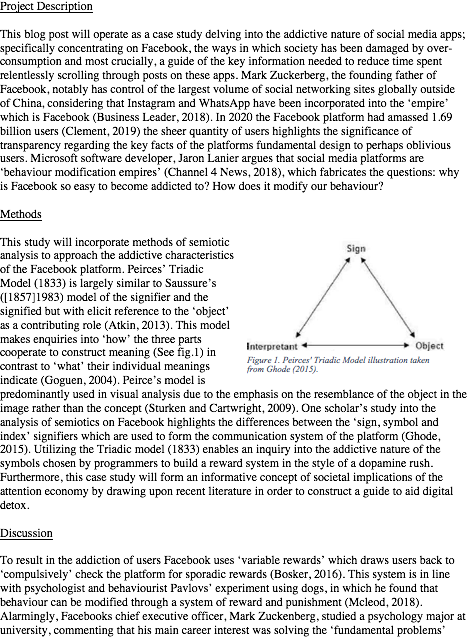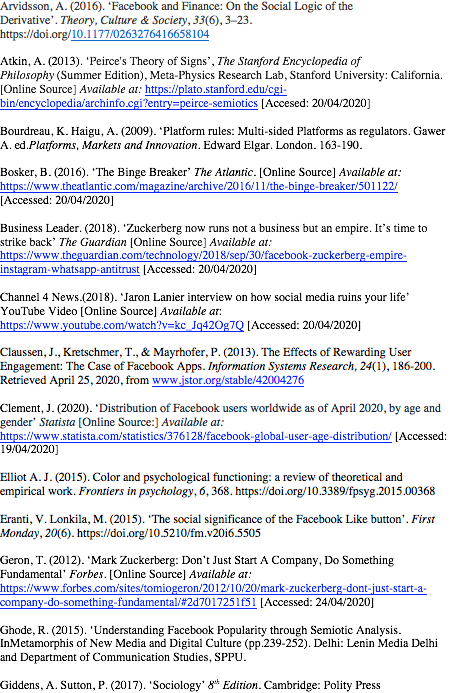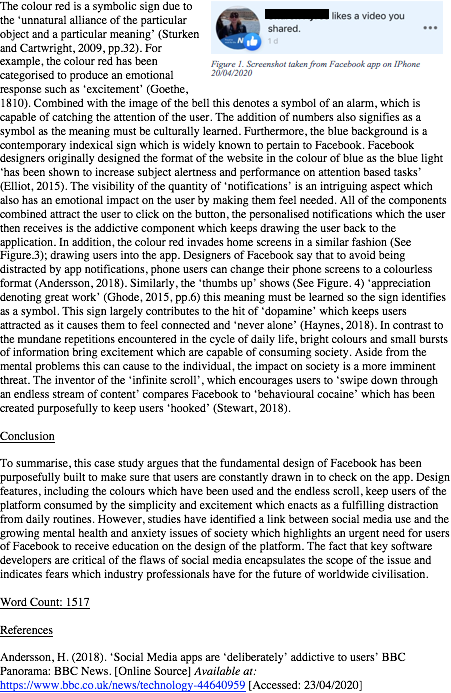Text
The crucial information needed to combat an addiction to Facebook- Post 1/4


0 notes
Text
Post 2: Digital Surveillance: WK/8
Digital surveillance in the current technological reality we live within transcends all traditional expectations of privacy. The issues of surveillance, which have been discussed in the lecture, provoked me to investigate further into the problematic outcomes of opening up our lives at the benefit of mega-corporations. Scholars have suggested that “people are choosing to trade privacy for convenience” (Lau et al, 2018). On the surface, this theory seems plausible but do people really know the extent of the information that they are giving away? Civilians may not even be aware of the ways in which their data is being ‘harvested’ by platforms which have been fundamentally designed to manipulate users (Lanier in Channel 4 News, 2018). Lanier argues that media platforms have been created to addict their users whilst dubbing social media as ‘the manipulation machine’ (Lanier, 2018). Moreover, is it possible that developments in virtual reality technologies will exploit consumer data even further?
One study suggests that most non-users are against buying a smart speaker due to the privacy implications yet users of smart speakers are ‘comfortable’ with trading their privacy for convenience (Lau et al, 2018). The National Cyber Security Centre has recently revealed reports that internet hackers have been able to gain access to home smart camera footage and baby monitors, thus enabling them to share onto the internet and ‘speak’ through the devices (Corera, 2020). An even greater concern arising from corporations possessing our data, is the thought of the government taking their pick out of surveillance footage. It is as if “626,707 CCTV cameras”- in London alone (Ratcliffe, 2019)- isn’t enough! Amazon invested “840 million dollars” in the purchase of home security company, Ring (Panorama, 2020), which established their business within the security industry. Police forces within the UK have been given assets of the doorbells to hand out for free, in turn this has encouraged surrounding residents to buy the product (Panorama, 2020). Al Now Institute Scholar, Meredith Whittaker (2020), describes this “partnership” as “basically turning police departments into ‘Avon sales people’ for Amazon Ring” (Panorama,2020).
However, a fundamental argument surrounding the topic of surveillance is ‘risk-management’; the use of surveillance to manage crime and deviancy (Lyon, 2010). Whilst Foucault perceived surveillance to have an equal effect on the individual, Bigo and Guild (2005) argue that social surveillance is used to single out those who should be free from state control and those who should be restricted. Furthermore, Foucault’s’ ‘Panopticism’ theories from ‘Discipline & Punishment: The Birth of the Prison’ (1979), are more than ever relevant to the high surveillance societies of the modern world. Seemingly, the intricate description at the beginning of the essay illustrates the social implications of living under an architectural imprisonment such as Bentham’s ‘Panopticon’, this extract anecdotally performs strict surveillance through a manner through which ordinary people can understand (Foucault, 1979). Referring to this essay induces shock at the development of ‘smart-home’ technology which within generations may become the inescapable norm.
We have to ask ourselves whether reality is rapidly evolving to mirror the dystopian society of George Orwell’s’ ‘Nineteen Eighty-Four’ (1949)?
References
Bigo, D. Guild, E. (2005) ‘Controlling Frontiers: Free movement into and within Europe’. Aldershot UK: Ashgate
Channel 4 News (2018) ‘Jaron Lanier Interview on how social media ruins your life’. YouTube video. Available at: https://www.youtube.com/watch?v=kc_Jq42Og7Q[Accessed: 24/03/2020
Corera, G. (2020) ‘Smart camera and baby monitor warning given by UK's cyber-defender’ Techonology, BBC NEWS [Online source] Available at: https://www.bbc.co.uk/news/technology-51706631
Foucault, M. (1979) ‘Discipline and Punishment: The Birth of the prison’. New York: Vintage
Lau, J. Zimmerman, B. Schaub, F. (2018) ‘Alexa, are you listening? Privacy perceptions, concerns and privacy-seeking behaviour with smart speakers’. Proceedings of the ACM on Human Computer Interaction, vol. 2. P.102
Lyon, D. (2004) ‘Surveillance, Power and Everyday life.’ Oxford Handbook of information and Communication, Technologies. Oxford. [Online Source] Available at: https://panoptykon.org/sites/default/files/FeedsEnclosure-oxford_handbook_3.pdf[Accessed: 19/03/2030]
Orwell, G. (1949) ‘Nineteen Eighty-Four’. Secker and Warburg.
Panorama (2020) ‘Amazon: What they know about us’ BBC. London. Available at:
https://www.bbc.co.uk/iplayer/episode/m000fjdz/panorama-amazon-what-they-know-about-us
Ratcliffe, J. (2019) ‘How many CCTV Cameras are there in London 2020?’CCTV Installation Experts [Online Source] Available at: https://www.cctv.co.uk/how-many-cctv-cameras-are-there-in-london/[Accessed: 19/03/2020]
Ted (2018) ‘How we need to remake the internet, Jaron Lanier’. YouTube Video. Available at: https://www.youtube.com/watch?v=qQ-PUXPVlos[Accessed: 24/03/2020]
0 notes
Text
Post 1: Fake News: WK/7
The term “fake news” is broadly used to define a range of misleading information (Wardle, 2017) which is often used for financial or political gain. A recent study which uses discourse analysis to unpack the term “fake news” highlights the typographic instances which are described by the phrase, these are; news satire, news parody, fabrication, manipulation, advertising, and propaganda (Edson. et al, 2017). These elements reveal the extensive variety which are included in the definition of fake news. For instance, many Twitter users make parody tweets, memes or satire to mock current affairs which could easily be taken out of context to be perceived as real news.
Hence Wardle’s (2017) theory highlights that the following three elements as being crucial in our understanding of fake news: 1. ‘the different types of content being created and shared’, 2. Content creators motive and 3. How this content is being shared (Wardle, 2017).
Social media sites, such as Twitter, display the amount of attention pertaining to each post on the platform. Arguably, the more attention a post has received will indicate the extent of attention it is yet to achieve (Thorson, 2008). This creates a ‘self-fulfilling cycle’ which escalates the dissemination of ‘un-verified’ news (Edson. et al, 2017). I decided to write a blog post about this particular lecture due to the current uncertainty of dis-information hysteria which has been looming over crucial international events. Particularly during a global health pandemic, fake news can be dangerous and unsettling. Coronavirus panic is gradually sweeping countries across the globe, which in turn, has brought with it deceiving health remedies. For example, Photo-Shopped images alleging that ‘cocaine kills coronavirus’ (see fig.1) accumulated viral attention on twitter thus forcing the French government to release a tweet countering the claims (Colson, 2020). Furthermore, I found an interesting post on my Facebook timeline (see fig 2 & 3) which had gained lots of attention, upon reading the article it is clear that the headline is being used to deceive and attract click bait. Studies reveal that six out of ten people will share a post on social media without reading it (Dewey, 2016). To combat the social hysteria of this issue the UK government set up a unit to ‘help provide a comprehensive picture on the potential extent, scope and impact of disinformation’ (BBC News, 2020).
In my opinion, Twitter is a crucial platform within today’s climate as it allows an open discussion and debate between an extremely wide audience. The notion of fake news undermines the agency of the public who are capable of delving further into the truth or lie behind a piece of information. Thus, perhaps an underlying criticism is that social media is a lazier way of consuming news? Or even that news consumption is - or should be - an overtly passive task. News journalism is perceived as a provider of “independent, reliable, accurate, and comprehensive information”(Kovach and Rosenstiel 2007, 11). Yet in many instances prior to wide-spread social media use, we have also seen this not to be the case.
Word Count: 529
References
BBC News (2020) ‘Coronavirus: Unit set up to counter false virus claims’. BBC News [Online source] Available at: https://www.bbc.co.uk/news/uk-politics-51800216[Accessed: 18/03/2020]
Colson, T. (2020) ‘A fake claim that cocaine cures the coronavirus is spreading online, and the French government was forced to tell people that it won't’ Markets Insider [Online Source] Available at: https://markets.businessinsider.com/news/stocks/coronavirus-cocaine-cure-fake-spreads-rebutted-by-french-government-2020-3-1028976143[Accessed: 20/03/2020
Dewey, C. (2016) ‘Six in ten of you will share this link without reading it, a new study says.’ The Washington Post[Online-source] Available at: https://www.washingtonpost.com/news/the-intersect/wp/2016/06/16/six-in-10-of-you-will-share-this-link-without-reading-it-according-to-a-new-and-depressing-study/[Accessed: 16/03/2020]
Edson C. Tandoc Jr., Zheng Wei Lim & Richard Ling (2018) Defining “Fake News”, Digital Journalism, 6:2, 137-153, DOI: 10.1080/21670811.2017.1360143
Kovach, B, and Rosenstiel, T. (2007). ‘The Elements of Journalism: What News People Should Know and The Public Should Expect. 1st rev ed. New York: Three Rivers Press.
Thorson, E. 2008. “Changing Patterns of News Consumption and Participation.” Information, Communication and Society 11 (4): 473–489. doi:10.1080/13691180801999027. [Taylor & Francis Online],
Wardle, C (2017) ‘Fake news. It’s Complicated.’ First Draft, Medium.com. [Online Source] Available at: https://medium.com/1st-draft/fake-news-its-complicated-d0f773766c79[Accessed: 19/03/2020]
1 note
·
View note


